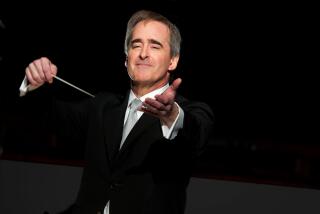At Pasadena Symphony, a musical puzzle played with high spirits
The Pasadena Symphony’s weekend program may have contained a musical puzzle and an “Enigma,” but the real question facing the orchestra, celebrating its 90th anniversary season, was whether there would be any fallout from the threatened musicians strike earlier this year.
Apparently, all is well. With the strike averted, the Saturday afternoon concert (followed by an encore performance that night) at the Ambassador Auditorium appeared sold out. As Music Director David Lockington brilliantly led the ensemble in Alexander Miller’s “Scherzo Crypto,” Rachmaninoff’s “Rhapsody on a Theme of Paganini” and Elgar’s “Enigma” Variations, the orchestra’s spirits seemed high.
Navigating every percussive hairpin turn in Miller’s colorfully propulsive “Scherzo” overture, Lockington and the orchestra seemed to revel in the mischievous score. As the conductor explained from the stage, the “crypto” part of Miller’s 2014 work involved a few passages where a puzzle — the name of a musical instrument — is hidden in the piece. A light at stage right went on to cue the audience each time a passage offered clues to the puzzle’s answer.
After that bracing piece, Lockington maintained a tight ensemble throughout Rachmaninoff’s dazzling “Rhapsody,” with pianist Andrew von Oeyen the first-rate soloist.
Von Oeyen, a 38-year-old Malibu native who now lives in Paris, made his American debut as a 16-year-old with Esa-Pekka Salonen and the Los Angeles Philharmonic. But it was only last year that Von Oeyen landed a major recording contract.
Unlike the skyrocketing early careers of pianists Yuja Wang and Daniil Trifonov, Von Oeyen’s path took longer. But after hearing his multihued account of Rachmaninoff’s “Rhapsody” (24 variations in all) and his sparkling reading of Ravel’s Concerto in G on his debut disc for Warner Classics, Von Oeyen’s career seems ready to take off.
Von Oeyen dashed off the knotty passages in the “Rhapsody” with elegance, crisply evoking Paganini’s legendary left-hand pizzicato in Variation 19. He also showed touching moderation in the score’s famously swooning tune in Variation 18. Nothing schmaltzy — just the music, please.
Lockington’s account wasn’t the most somberly Russian you’ll hear, but the performance flowed, with the orchestra conveying its many moods with precision and clarity.
After intermission Lockington, conducting from memory, delivered a stirring account of Elgar’s “Enigma,” 14 musical sketches celebrating and gently roasting family and friends, who are disguised in the score by initials and nicknames.
Lockington’s affectionate, clear-textured, warmly autumnal performance kept Elgarian solemnity and bombast from becoming heavy. Especially moving was the restrained grandeur of “Nimrod,” the emotional core of the piece, and “CAE,” the lovely opening tribute to the composer’s wife. The final variation, “EDU,” came off as the composer’s swashbuckling self-parody, with the Pasadena brass getting a full workout.
Oh, and what was the answer to Miller’s “Crypto” puzzle? For that, you’ll have to ask a devoted subscriber at the Pasadena Symphony’s all-Beethoven season finale on May 5.
See all of our latest arts news and reviews at latimes.com/arts.
ALSO
I survived 24 hours of Taylor Mac
A critic’s picks for classical concerts this spring
15 ways to experience SoCal’s chamber music scene
More to Read
The biggest entertainment stories
Get our big stories about Hollywood, film, television, music, arts, culture and more right in your inbox as soon as they publish.
You may occasionally receive promotional content from the Los Angeles Times.






